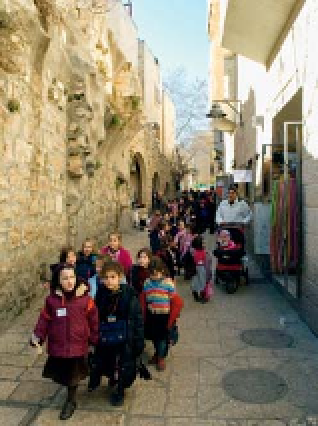Travel Reference
In-Depth Information
snack bars and cafés, including
the popular Quarter Café,
which serves kosher food and
offers great views of the Haram
esh-Sharif and Dome of the
Rock from its terrace.
Wohl
Archaeological
Museum
6
1 Ha-Karaim Street.
Map
4 D4.
Tel
(02) 628 3448.
#
9am-5pm
Sun-Thu, 9am-1pm Fri.
& ^
In the era of Herod the
Great (37-4 BC), the area
of the present-day Jewish
Quarter was part of a wealthy
“Upper City”, occupied for
the most part by the families
of important Jewish priests.
During post-1967 redevelop-
ment, the remains of several
large houses were unearthed
here. This rediscovered
Herodian quarter now lies
from 3 to 7 m (10 to 22 ft)
below street level, under-
neath a modern building,
and is preserved as the Wohl
Archaeological Museum.
The museum is remarkable
for its vivid evocation of every-
day life 2,000 years ago. All
the houses had an inner court-
yard, ritual baths, and cisterns
to collect rain, which was the
only source of water at the
time. The first part of the
museum, called the Western
House, has a mosaic in the
vestibule and a well-preserved
ritual bath
(mikveh)
. Beyond
this is the Middle
Complex, the remains
of two separate
houses where arch-
aeologists found a
maze-pattern mosaic
floor covered in burnt
wood; this, they
surmised, was fire
damage from the
Roman siege of
Jerusalem in AD 70.
The most complete of
all the Herodian build-
ings is the Palatial
Mansion, with more
splendid mosaic floors
and ritual baths.
The entrance fee
to the Wohl Museum
also covers admission
to the Burnt House
(see p84)
.
Hurva Square, the social and commercial hub of the Jewish Quarter
the Old City in 1967, a single
arch of the synagogue's main
façade was reconstructed.
Currently, work on the
structure is underway again
and it is expected that by
2010 the renovations will
have been completed.
Tiferet Yisrael
Street
5
Map
4 D4.
This is one of the busiest
streets in the Jewish Quarter.
It connects Hurva Square
with the stairs that descend
towards the Western Wall.
Partway along is the shell
of the ruined
Tiferet Yisrael
Synagogue
, destroyed in the
1948 War and left gutted as a
memorial. Sectarian feelings
run high around here, and
local souvenir shops stock
contentious items such as
Israeli Army T-shirts and
postcards of the Haram
esh-Sharif with its mosques
replaced by the “future Third
Temple”. The street ends in
an attractive tree-shaded
square which has several
Ramban
Synagogue
4
Hurva Square.
Map
3 C4.
#
for
morning and evening prayers.
7
When the Spanish rabbi and
scholar Moses Ben Nahman
(Nahmanides) arrived in
Jerusalem in 1267, he was
shocked to find only a handful
of Jews in the city. He dedi-
cated himself to nurturing a
Jewish community and bought
land near King David's Tomb
on Mount Zion in order to
build a synagogue. Some time
around 1400, the synagogue
was moved to its present site.
It was perhaps the first time
there had been a Jewish
presence in this quarter of
the Old City since the exile
of the Jews in AD 135. The
synagogue had to be rebuilt
in 1523 after it collapsed. It
is believed that, at this time,
it was probably the only
Jewish place of worship in
what was then Ottoman-
controlled Jerusalem. In 1599
the authorities banned the
Jews from worship in the
synagogue and the building
became a workshop. It was
not until the Israelis took
control of the Old City in
1967 that it was restored as
a place of worship.
Tiferet Yisrael Street, one of the liveliest
thoroughfares in the Jewish Quarter











